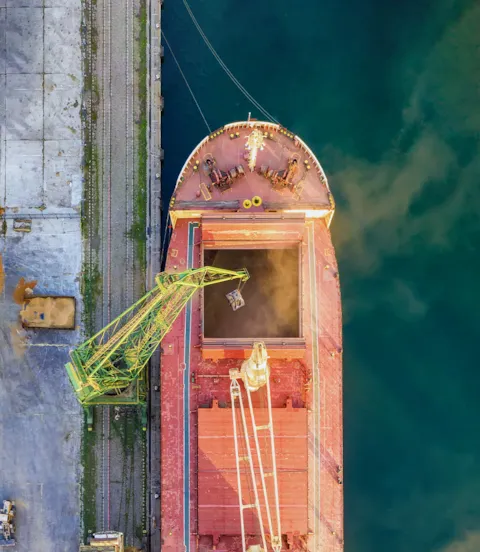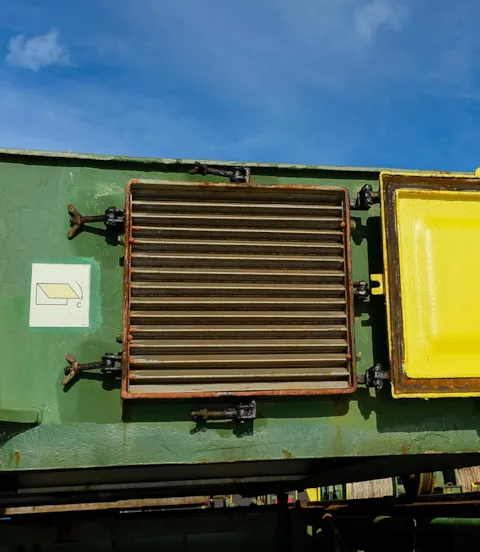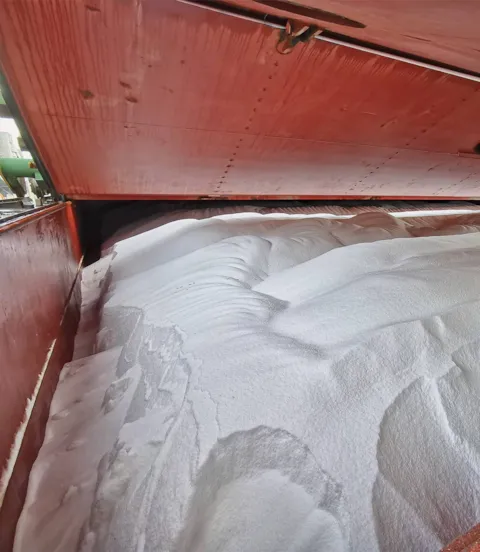New guidance document for cargo and cargo hold ventilation
Many cargo shipments transported in bulk form can suffer damage or even pose a hazard to the crew while in transit. The new guidance document from the Standard Club, INTERCARGO and DNV GL helps masters with practical recommendations and a better understanding of how to mitigate these risks by ensuring proper ventilation.

Ventilation guide takes a closer look at risks
INTERCARGO, the Standard Club and DNV GL have jointly developed a guidance document called ‘Cargo and cargo hold ventilation’ which looks at the specific risks associated with particular types of cargo and how ventilation should be applied to mitigate them. “The guide will provide ships’ crew with a practical understanding of when to ventilate and the reasons to do so,” says Ed Wroe, Technical Manager at INTERCARGO.

Ship sweat and cargo sweat
“By far the most common threat to cargo integrity is ‘sweat’, the condensation of air moisture, which can cause agricultural products to spoil, steel products to rust, and other cargo types to undergo unwanted and potentially hazardous chemical reactions,” points out Yves Vandenborn, Director of Loss Prevention at the Standard Club. When air moisture settles on the cargo, it is referred to as ‘cargo sweat’. Condensation on the ship’s structural elements inside the cargo hold is called ‘ship sweat’. Both phenomena are directly related to the dew point, the temperature at which air becomes saturated with water, triggering condensation.

Cargo types susceptible to interaction with sweat
Organic matter, such as grains, animal feed, seed cake, timber or wood pulp, may decompose or ferment when exposed to sweat. Non-organic and/or hygroscopic cargo that can absorb or release moisture, such as fertilizer, salt, sugar or minerals, can react chemically with water and may self-heat and emit carbon monoxide, carbon dioxide or methane. Apart from the resulting degradation of product quality, carbon monoxide is toxic to humans, and carbon dioxide can displace atmospheric oxygen and cause asphyxiation if undetected. Both gases are odourless.
Some non-organic cargo shipments, especially silicomanganese and ferrosilicon, can emit toxic gases such as hydrogen, especially when moist. Coal and direct-reduced iron may in the same way self-heat and cause fire in the cargo hold as well as emit hazardous methane under the wrong atmospheric conditions. Both hydrogen and methane are highly explosive.

Hazards on board
Several cargo types may pose fire, explosion and health risks. Further, non-odorous toxic gases or an oxygen-depleted atmosphere in a cargo hold pose an immediate danger to anyone entering. What is more – toxic gases exiting from cargo holds, whether by natural or mechanical ventilation or through leaks, could enter crew accommodations and in worst case cause injury or death if not detected at an early stage. Certain cargo shipments produce dust that can also pose a health hazard. Mixing hygroscopic and non-hygroscopic cargo shipments with different inherent temperatures in the same hold adds additional risks.

Ventilation mitigates risks
“Cargo hold ventilation is the established means to mitigate these risks,” explains Ed Wroe from INTERCARGO. “The critical question is how and to what extent ventilation is advisable. In some cases, ventilation may actually aggravate the hazard by increasing the amount of moisture and oxygen interacting with the cargo, thereby accelerating the processes which taint the cargo or cause it to self-heat and emit dangerous gases.”
“Deciding when and how to ventilate can therefore be a complex task,” admits Morten Løvstad, Business Director – Bulk Carriers at DNV GL. “The ‘Cargo and cargo hold ventilation’ guidance document explains in detail what masters and crew should pay attention to, how their decisions will affect cargo quality as well as safety on board, and what the relevant codes, regulations and standards tell them to do. It also points out how operational flexibility is heavily impacted by what ventilation equipment is available on board the vessel.”

Natural ventilation system
There are generally two types of ventilation – natural and mechanical or forced ventilation. Natural ventilation relies on air circulation driven by convection, with outside air entering and inside air exiting the hold through vents located above the deck level. Today’s bulk carriers typically have hinged-door type ventilators located at the sides of the hatch covers. These can be opened or closed depending on the relative wind direction to ensure adequate surface ventilation and prevent sweat inside the hold.

Mechanical ventilation system
Mechanical ventilation systems actively blow air across or through the cargo hold to remove hazardous gases or vapours. If the cargo is prone to self-heating in the presence of moisture, mechanical ventilation should be applied in specific circumstances only. In some situations, air-conditioning or specialized dehumidifying equipment should be used instead of ventilation to remove moisture from the atmosphere in the hold. Where flammable gases might be present, the ventilation fans must be designed to avoid sparking and ignition or explosion.

Monitoring and maintenance ensure proper ventilation
It is important to ensure proper monitoring and maintenance of all ventilation openings and equipment, not only to guarantee proper operation but also to avoid cargo contamination by falling rust or paint chips, and to prevent sea or spray water from entering a hold in heavy weather.

Complex regulatory landscape for cargo hold ventilation
It takes careful consideration of all influential factors and proper preparation ahead of a voyage to make sure that the cargo hold ventilation achieves the intended purpose. The charter party or voyage order may contain specific instructions, for example, ventilation rule applicable for the voyage or the period when ventilation might not be possible due to in-transit fumigation of the cargo. Furthermore, the IMSBC Code, SOLAS regulations, the International Convention on Load Lines (ICLL) and several IMO Resolutions contain important recommendations and rules relating to cargo hold ventilation and related equipment. The ‘Cargo and cargo hold ventilation’ guidance document makes frequent reference to the applicable codes and documents to help crews understand the implications.

Crew knowledge about transported cargo is key
Familiarity of the crew with the nature and specific properties of the cargo carried is essential. “Suitable equipment must be available on board to measure key influential parameters, such as cargo and ambient temperature, relative humidity and dew point inside and outside the hold, and sea temperature,” stresses Vandenborn. “These measurements should be repeated regularly during the voyage to predict their influence on the atmosphere inside the cargo holds. All readings, events and measures taken with regard to the cargo and its condition should be logged to provide a continuous record in case any issues emerge upon the arrival of the ship at the destination.”

Case studies provide insights on proper and improper ventilation
The document closes with two case studies which illustrate how improper or inconsistent application of ventilation rules can cause cargo damage and financial loss, and how proper documentation during a voyage is key to a ship’s ability to defend itself against cargo claims. A brief glossary of terms, a cargo temperature and ventilation log template, and a dew point table are included as additional practical tools.
- Eduard Valentinov – Shutterstock.com
- Ievgen Postovyk – Shutterstock.com
- Optimum Marine Management Ltd Ionic Shipping (Mgt) Inc.
- Eugene – stock.adobe.com
- CWA International Ltd